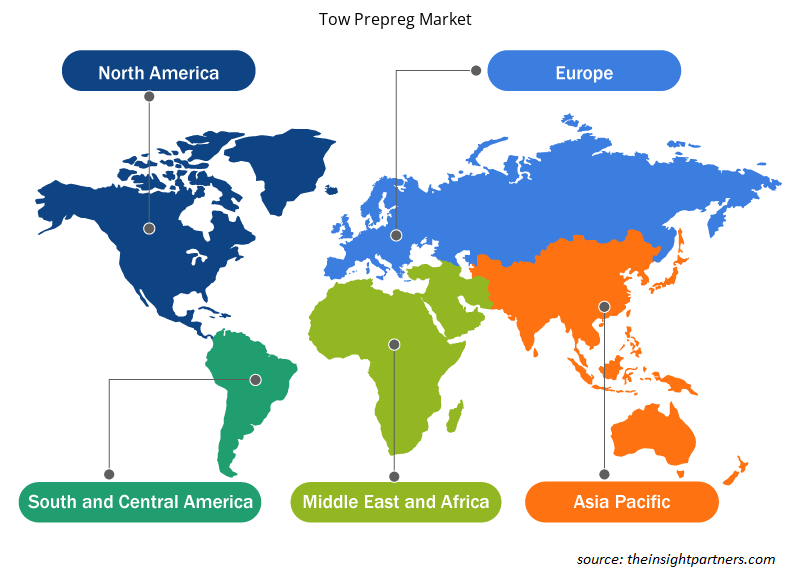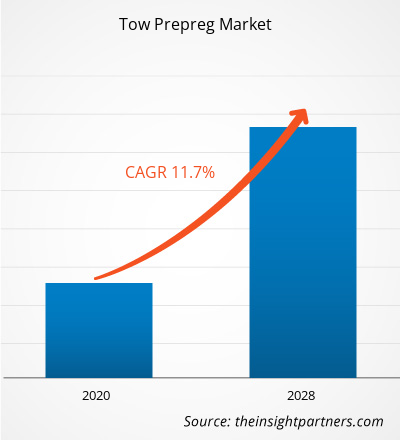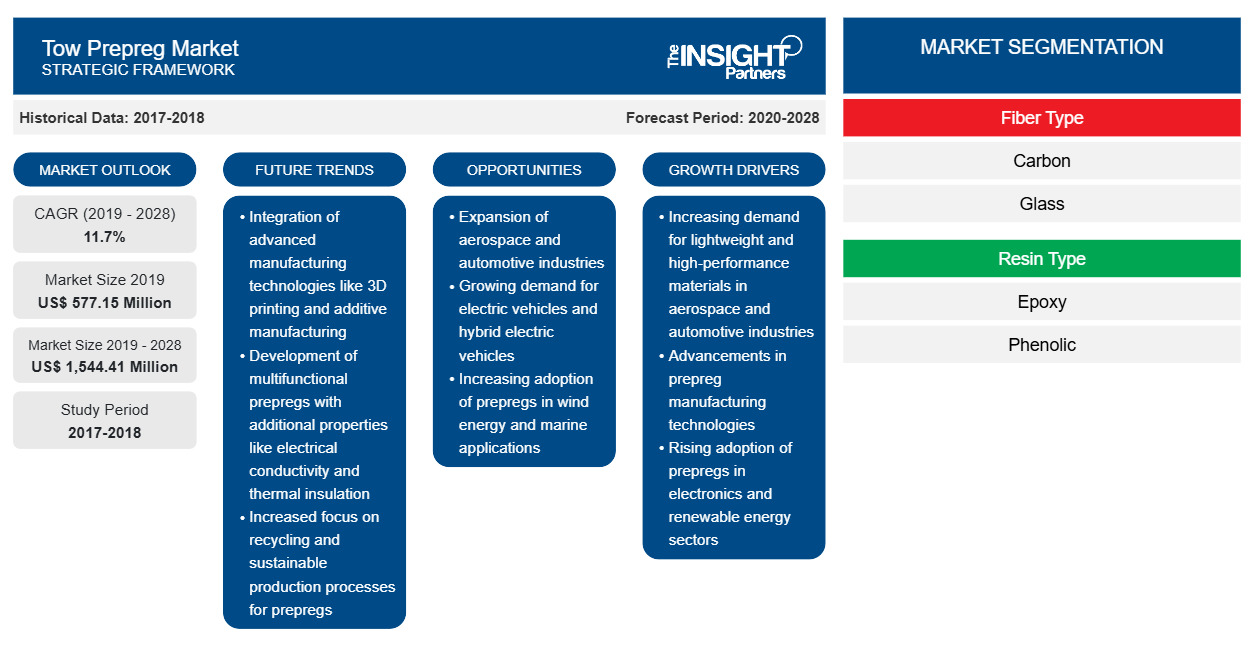Der Markt für Tow-Prepregs hatte im Jahr 2019 einen Wert von 577,15 Millionen US-Dollar und soll bis 2028 einen Wert von 1.544,41 Millionen US-Dollar erreichen; von 2020 bis 2028 wird mit einer durchschnittlichen jährlichen Wachstumsrate von 11,7 % gerechnet.
Tow-Prepregs bestehen aus Glasfaserfilamenten, Kohlenstoff und duroplastischem Harz, das als Bindemittel dient. Die zunehmende Anwendung von Tow-Prepregs in verschiedenen Industriezweigen sowie die steigende Nachfrage nach leichten und kostengünstigen Materialien treiben das Wachstum des Tow-Prepreg-Marktes voran. Die schnelle Urbanisierung in Verbindung mit Wirtschaftswachstum und erheblichen Investitionen in Forschungs- und Entwicklungsaktivitäten dürften im Prognosezeitraum ebenfalls die Nachfrage nach Tow-Prepregs fördern.
Der asiatisch-pazifische Raum wird im Prognosezeitraum voraussichtlich der am schnellsten wachsende Markt im globalen Tow-Prepreg-Markt sein . Das Marktwachstum für Tow-Prepreg in dieser Region ist in erster Linie auf die Präsenz einer starken industriellen Basis zurückzuführen, zusammen mit namhaften Herstellern, die erheblich zum Marktwachstum beitragen. Darüber hinaus treiben das Wachstum der Automobil- und Transportindustrie, unterstützt durch den Wandel des Lebensstandards und das hohe Wachstumspotenzial in China, Indien und anderen derartigen Volkswirtschaften, die Nachfrage nach Tow-Prepreg erheblich an. Die steigenden ausländischen Direktinvestitionen zusammen mit den steigenden Produktionsausgaben für bessere Produktangebote bieten lukrative Möglichkeiten für das Marktwachstum im asiatisch-pazifischen Raum. Der Anstieg der Mittelschichtbevölkerung zusammen mit dem Wachstum der Urbanisierung treiben das Wachstum des Tow-Prepreg-Marktes voran. Der Fertigungssektor im asiatisch-pazifischen Raum übernimmt schnell die innovativen Beschleuniger, zu denen fortschrittliche Technologien und Prozesse gehören. Die einfache Zugänglichkeit und Verfügbarkeit von Rohstoffen, billige Arbeitskräfte und niedrige Produktionskosten beschleunigen das Marktwachstum in der Region.
COVID-19 hat sich aufgrund von staatlich verhängten Ausgangssperren, Reiseverboten und Betriebsschließungen negativ auf die Wirtschaft und Industrie in verschiedenen Ländern ausgewirkt. Die Chemie- und Materialindustrie ist eine der wichtigsten Branchen, die unter ernsthaften Störungen wie Unterbrechungen der Lieferkette, Absagen von Technologieveranstaltungen und Büroschließungen leidet. Die Schließung verschiedener Werke und Fabriken in Nordamerika, Europa, im asiatisch-pazifischen Raum, in Südamerika sowie im Nahen Osten und Afrika hat die globale Lieferkette eingeschränkt und sich negativ auf die Fertigungsaktivitäten, Lieferpläne und Produktverkäufe ausgewirkt. Darüber hinaus haben verschiedene Unternehmen bereits mögliche Verzögerungen bei Produktlieferungen und einen Einbruch der zukünftigen Verkäufe ihrer Produkte vorhergesagt. Die von Ländern in Europa, Asien und Nordamerika verhängten Reiseverbote behindern die Möglichkeiten für Geschäftskooperationen und Partnerschaften. All diese Faktoren behindern die Aktivitäten in der Chemie- und Materialindustrie und bremsen das Wachstum verschiedener mit dieser Branche verbundener Märkte. In vielen Ländern kehrt nun die Normalität zurück, während viele eine zweite Welle des Ausbruchs erleben. Darüber hinaus ändern sich aufgrund von Impfkampagnen derzeit die Situationen auf der ganzen Welt.
Passen Sie diesen Bericht Ihren Anforderungen an
Sie erhalten kostenlose Anpassungen an jedem Bericht, einschließlich Teilen dieses Berichts oder einer Analyse auf Länderebene, eines Excel-Datenpakets sowie tolle Angebote und Rabatte für Start-ups und Universitäten.
-
Holen Sie sich die wichtigsten Markttrends aus diesem Bericht.Dieses KOSTENLOSE Beispiel umfasst eine Datenanalyse von Markttrends bis hin zu Schätzungen und Prognosen.
Markteinblicke
Steigende Nachfrage nach leichten und kosteneffizienten Materialien
Die Nachfrage nach leichten Materialien mit hoher Zugfestigkeit steigt in mehreren Branchen, darunter Automobil und Transport, Luft- und Raumfahrt, Schifffahrt und Bauwesen. Die Verwendung von leichten Materialien hat direkte Auswirkungen auf die Gesamtdynamik und Struktur der Komponenten, in denen sie verwendet werden. Tow Prepreg ist ein solches Verbundmaterial, das mit Harz vorimprägniert ist, um seine Produktivität zu steigern und die Verwendung von Harzbeschichtungen zu vermeiden. Es ist bekannt für seine gute Elastizität, hohe Dimensionsstabilität, hervorragende mechanische und elektrische Eigenschaften sowie Festigkeit. Das geringe Gewicht und die Kosteneffizienz machen Tow Prepreg zu einer idealen Komponente für mehrere Anwendungsbereiche. Die Nachfrage nach Tow Prepreg-Verbindungen ist in verschiedenen Branchen aufgrund zunehmender Fortschritte und Innovationen in diesen Branchen erheblich gestiegen. Das Gewicht ist neben der Festigkeit zu einem wichtigen Faktor für die Leistung eines Fahrzeugs geworden. Beispielsweise kann eine leichte Gewichtsreduzierung die Leistung eines Fahrzeugs verbessern. Dies hat eine großartige Chance für das Wachstum des Tow Prepreg-Marktes auf globaler Ebene geboten. Verbundwerkstoffe sind zu einem strategischen Kernmaterial für Erstausrüster (OEMs) in der Automobil- und Transportbranche sowie für Bauteile aus der Luft- und Raumfahrt geworden. Darüber hinaus hat die zunehmende Präferenz für kostengünstige Verbundwerkstoffe in preissensiblen Branchen die Prepreg-Hersteller dazu motiviert, weniger kostspielige, aber energieintensive Faservorläufer wie Tow-Prepreg einzusetzen. All diese Faktoren dürften die Nachfrage nach Tow-Prepreg steigern.Prepreg is one such compound material, which is preimpregnated with resin to increase its productivity and eliminate the use of resin coating. It is known to possess good elasticity, high dimensional stability, excellent mechanical and electrical properties, and strength. Lightweight nature and cost-efficiency make tow prepreg an ideal component across several application bases. The demand for tow prepreg compounds has considerably increased across various industries, owing to rise in advancements and innovations in these industries. Weight, along with strength, has become a significant factor for the performance of a vehicle. For instance, a slight reduction in the weight can improve the performance of a vehicle. This has offered a great opportunity for the growth of the tow prepreg market in global scenario. Composites have become a core strategic material for automotive and transportation Original Equipment Manufacturers (OEMs), as well as aerospace components. Moreover, the growing preference toward cost-effective composite materials in price-sensitive industries has motivated the prepreggers to adopt less costly but energy-intensive fiber precursors such as tow prepreg. All such factors are expected to boost the demand for tow prepreg.
Einblicke in den Fasertyp
Der globale Tow-Prepreg-Markt ist nach Fasertyp in Kohlenstoff, Glas und andere unterteilt. Kohlenstofffaser-Tow ist ein Faden, der zum Weben von Kohlenstofffasergeweben verwendet wird. Das Kohlenstofffaser-Tow-Prepreg ist in den Endverbrauchsbranchen wie Automobil und Transport, Luft- und Raumfahrt und Verteidigung sowie Sport und Freizeit stark gefragt. Diese Faser hat den höchsten Festigkeitsmodul im Vergleich zu den anderen Fasertypen. Dieses Tow-Prepreg verfügt außerdem über eine hohe Zugfestigkeit und einen hohen Elastizitätsmodul. Unternehmen wie ENEOS Corporation produzieren und verkaufen Kohlenstofffaser-Verbundwerkstoffe. Durch die Kombination der unabhängig entwickelten Harze mit Kohlenstofffasern vom Pechfasertyp und PAN-Fasertyp sowie den vom Kunden angeforderten Fasern, einschließlich Glasfasern und technischen Kunststofffasern, entwickelt das Unternehmen Tow-Prepregs entsprechend den Anforderungen der Kunden.Prepreg market, by fiber type, is segmented into carbon, glass, and others. Carbon fiber tow is a thread utilized to weave carbon fiber fabrics. The carbon fiber tow prepreg is highly demanded from the end-use industries such as automotive & transportation, aerospace & defense, and sports & recreational sectors. This fiber has the highest strength modulus than the other fiber types. This tow prepreg also possesses high tensile strength & elastic modulus. Companies such as ENEOS Corporation are manufacturing and selling carbon fiber composite materials. Combining the independently developed resins along with pitch-fiber type & PAN-fiber type carbon fibers as well as the customer-requested fibers, including glass fibers & engineering plastic fibers, the company develops tow prepregs according to the needs of the customers.
Einblicke in den Harztyp
Der globale Tow-Prepreg-Markt ist nach Harztyp in Epoxidharz, Phenolharz und andere unterteilt. Das Epoxidharzsegment war 2019 mit dem größten Anteil Marktführer. Epoxidverbindungen oder Glycidylverbindungen umfassen Glycidylester, Diglycidylester und Glycidylamine sowie andere Fasertypen von Epoxidverbindungen, die als reaktive Verdünnungsmittel bekannt sind und den Basisharzen zusätzlich zugesetzt werden, um die Leistungsmerkmale anzupassen. Unter den verschiedenen Fasertypen der hergestellten Epoxidharze haben die Harze vom Typ Diglycidylether von Bisphenol A (DGEBPA) aufgrund ihrer Vielseitigkeit an Bedeutung gewonnen. Epoxidharz besitzt eine robuste Strukturlänge und einen starken Bindungsfaktor, was es zu einem weit verbreiteten Element zum Auffüllen von Hohlräumen zwischen den Teilen macht. Ein Epoxidharz besteht aus zwei Teilen, die ungefähr gemischt werden müssen. Epoxidharze sind in verschiedenen Quetscharten und unterschiedlichen Größen erhältlich. Verschiedene Epoxidharze haben mehrere Funktionen wie Schutzabdeckung, Füllung und Ausbesserung. Die Funktion des Epoxidharzes besteht darin, den Epoxidfaser-Prepreg-Verbundstoffen eine starke Bindungseigenschaft zu verleihen. Darüber hinaus bietet Epoxidharz hohe Zugfestigkeit, Benetzbarkeit, hohe chemische und Umweltbeständigkeit, starke Haftung und bessere elektrische Eigenschaften.
Einblicke in die Endverbraucherbranche
Der globale Tow-Prepreg-Markt ist nach Endverbrauchsbranche in die Branchen Luft- und Raumfahrt und Verteidigung, Automobil und Transport, Sport und Freizeit, Öl und Gas und andere unterteilt. Das Segment Luft- und Raumfahrt und Verteidigung war 2019 mit dem größten Anteil Marktführer. Ein Verbundwerkstoff besteht typischerweise aus relativ starken und steifen Fasern in einer zähen Harzmatrix. Innovative Leichtbaustrukturen sowie hochkomplexe Flugzeugkomponenten werden aus modernen Leichtbaumaterialien wie Carbonfaser-Tow-Prepreg hergestellt. Im Vergleich zu herkömmlichen Produktionstechnologien für verschiedene Verbundwerkstoffe verarbeitet dieser Hybridwerkstoff auch eine Technologie, die kurze Zykluszeiten, Funktionsintegration, optimale Materialnutzung, hohe Gestaltungsfreiheit und weniger Nacharbeit ermöglicht. Zur Herstellung der Kabine, der Fracht und anderer Flugzeugkomponenten kann eine direkte Implementierung metallischer Elemente, einschließlich Einsätze, und die Verwendung dieses Verbundwerkstoffs realisiert werden. Darüber hinaus kann diese Prozesstechnologie vollständig automatisiert werden, um eine höhere Wirtschaftlichkeit zu erzielen. Aktuelle Verbundkomponenten für den Innenraum von Flugzeugen verwenden häufig eine Sandwichkonstruktion aus Glasfaser/Phenol, die sich durch einen geringen Buy-to-Fly-Materialverbrauch, hohe Zykluszeiten und umfangreiche Nacharbeit/Finishing auszeichnet.
Einige wichtige Akteure auf dem globalen Tow-Prepreg-Markt sind Mitsubishi Chemical Corporation, Hexcel Corporation, Teijin Limited, Toray Industries Inc. und SGL Carbon. Die wichtigsten Marktteilnehmer konzentrieren sich auf Strategien wie Fusionen und Übernahmen sowie Produkteinführungen, um ihre geografische Präsenz und Kundenbasis weltweit zu vergrößern. So kündigte Mitsubishi Chemical Corporation im Jahr 2020 die Übernahme eines deutschen Herstellers von Carbonfaser-Prepregs, der cmp GmbH, an, der über eine hervorragende Produktionstechnologie für unidirektionales/Gewebe-Prepreg verfügt und Lösungen für mehrere Märkte anbietet, insbesondere in den Bereichen Automobil und Luftfahrt. Durch diese Übernahme wird Mitsubishi Chemical Corporation über Prepreg-Fabriken in Europa, den USA und Japan verfügen.
Bericht-Spotlights
- Fortschrittliche Branchentrends auf dem globalen Tow-Prepreg-Markt helfen den Akteuren bei der Entwicklung wirksamer langfristiger Strategien
- In Industrie- und Entwicklungsländern angewandte Strategien für Unternehmenswachstum
- Quantitative Analyse des Marktes von 2017 bis 2028
- Schätzung der Nachfrage nach Tow-Prepregs in verschiedenen Branchen
- PEST-Analyse zur Veranschaulichung der Wirksamkeit der in der Branche tätigen Käufer und Lieferanten bei der Vorhersage des Marktwachstums
- Aktuelle Entwicklungen zum Verständnis der Wettbewerbssituation auf dem Markt und der Nachfrage nach Tow-Prepregs.
- Markttrends und -aussichten in Verbindung mit Faktoren, die das Wachstum des Tow-Prepreg-Marktes vorantreiben bzw. bremsen.
- Entscheidungsprozess durch das Verständnis von Strategien, die das kommerzielle Interesse im Hinblick auf das Wachstum des globalen Tow-Prepreg-Marktes untermauern
- Tow Prepreg Marktgröße an verschiedenen Knotenpunkten des Marktes
- Detaillierte Übersicht und Segmentierung des globalen Tow-Prepreg-Marktes sowie seiner Dynamik in der Branche
- Tow-Prepreg-Marktgröße in verschiedenen Regionen mit vielversprechenden Wachstumschancen
Regionale Einblicke in den Tow-Prepreg-Markt
Die regionalen Trends und Faktoren, die den Tow-Prepreg-Markt während des Prognosezeitraums beeinflussen, wurden von den Analysten von Insight Partners ausführlich erläutert. In diesem Abschnitt werden auch Tow-Prepreg-Marktsegmente und die Geografie in Nordamerika, Europa, im asiatisch-pazifischen Raum, im Nahen Osten und Afrika sowie in Süd- und Mittelamerika erörtert.

- Erhalten Sie regionale Daten zum Tow-Prepreg-Markt
Umfang des Tow Prepreg-Marktberichts
| Berichtsattribut | Details |
|---|---|
| Marktgröße im Jahr 2019 | 577,15 Millionen US-Dollar |
| Marktgröße bis 2028 | 1.544,41 Millionen US-Dollar |
| Globale CAGR (2019 - 2028) | 11,7 % |
| Historische Daten | 2017-2018 |
| Prognosezeitraum | 2020–2028 |
| Abgedeckte Segmente |
Nach Fasertyp
|
| Abgedeckte Regionen und Länder |
Nordamerika
|
| Marktführer und wichtige Unternehmensprofile |
|
Dichte der Marktteilnehmer für Tow-Prepreg: Die Auswirkungen auf die Geschäftsdynamik verstehen
Der Markt für Tow-Prepregs wächst rasant, angetrieben durch die steigende Nachfrage der Endverbraucher aufgrund von Faktoren wie sich entwickelnden Verbraucherpräferenzen, technologischen Fortschritten und einem größeren Bewusstsein für die Vorteile des Produkts. Mit steigender Nachfrage erweitern Unternehmen ihr Angebot, entwickeln Innovationen, um die Bedürfnisse der Verbraucher zu erfüllen, und nutzen neue Trends, was das Marktwachstum weiter ankurbelt.
Die Marktteilnehmerdichte bezieht sich auf die Verteilung der Firmen oder Unternehmen, die in einem bestimmten Markt oder einer bestimmten Branche tätig sind. Sie gibt an, wie viele Wettbewerber (Marktteilnehmer) in einem bestimmten Marktraum im Verhältnis zu seiner Größe oder seinem gesamten Marktwert präsent sind.
Die wichtigsten auf dem Tow-Prepreg-Markt tätigen Unternehmen sind:
- Arisawa Manufacturing Co., Ltd.
- Mitsubishi Chemical Corporation
- Red Composites GmbH
- SGL Carbon
- TCR Composites, Inc.
Haftungsausschluss : Die oben aufgeführten Unternehmen sind nicht in einer bestimmten Reihenfolge aufgeführt.

- Überblick über die wichtigsten Akteure auf dem Tow Prepreg-Markt
Tow-Prepreg-Markt, nach Fasertyp
- Kohlenstoff
- Glas
- Sonstiges
Tow-Prepreg-Markt, nach Harztyp
- Epoxid
- Phenol
- Sonstiges
Tow-Prepreg-Markt nach Endverbrauchsbranche
- Luft- und Raumfahrt und Verteidigung
- Automobil und Transport
- Sport und Freizeit
- Öl und Gas
- Sonstiges
Firmenprofile
- Arisawa Manufacturing Co., Ltd.
- Mitsubishi Chemical Corporation
- Red Composites GmbH
- SGL Carbon
- TCR Composites, Inc.
- Teijin Limited
- ENEOS Corporation
- HEXCEL CORPORATION
- PORCHER INDUSTRIES
- TORAY INDUSTRIES, INC.
- Historische Analyse (2 Jahre), Basisjahr, Prognose (7 Jahre) mit CAGR
- PEST- und SWOT-Analyse
- Marktgröße Wert/Volumen – Global, Regional, Land
- Branchen- und Wettbewerbslandschaft
- Excel-Datensatz
Aktuelle Berichte
Erfahrungsberichte
Grund zum Kauf
- Fundierte Entscheidungsfindung
- Marktdynamik verstehen
- Wettbewerbsanalyse
- Kundeneinblicke
- Marktprognosen
- Risikominimierung
- Strategische Planung
- Investitionsbegründung
- Identifizierung neuer Märkte
- Verbesserung von Marketingstrategien
- Steigerung der Betriebseffizienz
- Anpassung an regulatorische Trends























 Kostenlose Probe anfordern für - Markt für Tow-Prepreg
Kostenlose Probe anfordern für - Markt für Tow-Prepreg